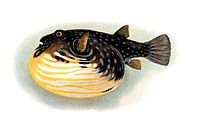
Photo from wikipedia
ABSTRACT The maximum amount of oxygen consumed during forced exercise (V̇O2,max) sets the upper limit to the effort that can be sustained over relatively long periods and can limit activity… Click to show full abstract
ABSTRACT The maximum amount of oxygen consumed during forced exercise (V̇O2,max) sets the upper limit to the effort that can be sustained over relatively long periods and can limit activity levels in nature. Among ectotherms, V̇O2,max is primarily affected by body size and body temperature, but it should also co-adapt with behavior, ecology and life history aspects. We compiled published data from 11 different families of lizards, including 58 species and 7 populations (total of 65 data points) and tested whether V̇O2,max was related to diet (herbivore, insectivore, insectivore/carnivore, carnivore and omnivore), climate (tropical, temperate and arid), nocturnality, viviparity or family. We fitted models that included body mass and measurement temperature as covariates, and all possible combinations of other independent variables using ordinary least squares (OLS) and phylogenetic regressions assuming an Ornstein–Uhlenbeck model of residual trait evolution (RegOU). The sum of Akaike weights for each independent variable revealed viviparity (Σwi=0.996) and the combined set of dummy variables coding for helodermatids, varanids and skinks (Σwi=0.996) as the most important predictors. These three families had relatively high V̇O2,max and are composed mainly of active foragers that probably benefit from higher V̇O2,max. Viviparity had a negative effect on V̇O2,max. Ecological or behavioral factors associated with viviparity (e.g. activity levels), but not included here, may explain this effect. The average allometric slope of V̇O2,max from the top eight models (which accounted for 99% of the cumulative evidence) was 0.803, which is similar to that reported previously for lizards and for mammals in general. Summary: Among species of lizards, helodermatids, varanids and skinks (which are mainly active foragers) have relatively high maximal aerobic capacity during forced exercise (V̇O2,maxV̇O2,max), whereas viviparous species have relatively low V̇O2,maxV̇O2,max.
Journal Title: Journal of Experimental Biology
Year Published: 2020
Link to full text (if available)
Share on Social Media: Sign Up to like & get
recommendations!